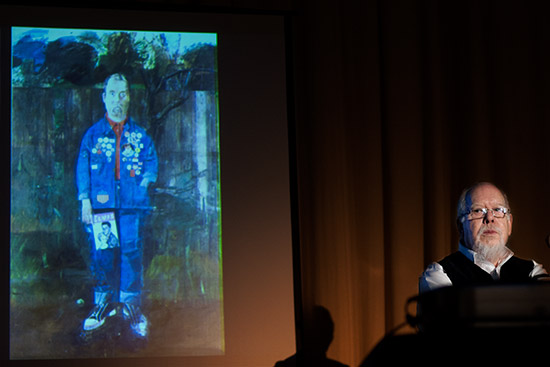Like a few males of a certain age I like playing music via my hifi system and to keep abreast of things I joined a couple of online forums (fora?). I won’t name them but I’m sure you’ll find them if you search for UK hifi forums. Most of the stuff posted there about valves, vinyl, cables, mains conditioners is complete and utter crap; as Alan Shaw the respected designer of Harbeth loudspeakers frequently points out.
I love this comment from him about speaker cables:
‘We noted recently that the signal from the microphone to the loudspeaker comprises a line. A line of electrons flowing towards the voice coil of the speaker drive units. Because the voice coils are in a magnetic field, and the voice coil is glued to a speaker cone, we can hear a sound.
Before we get too carried away with spending money on the speaker cable that connect the amp to the speakers, and which is sometimes the thickness of a hose pipe, what about the part of the chain that you the consumer can’t play with? The voice coil wire itself.
Did you appreciate that the voice coil wire is not much thicker than a human hair? And if we unwind a voice coil from a RADIAL 5″ or 8″ woofer we can stretch it out a long way …. far longer than the cable typically used to connect your amp to your speakers! So, on the basis of the sound be limited by the weakest link – in this case the thinnest wire – I’m satisfied that QED79 strand (or equivalent) is ‘more than adequate enough to get you going’.
It really is most bizzare and it’s like the world hasn’t changed since the video above. There is almost a universal lack of scientific knowledge and a desire to ‘believe any old crap’. This is perpetuated by an industry selling dreams of perfect and better sound to the delusional. Some audiophiles call themselves ‘subjectivists’ (i.e. if I can hear the improvement it is better) and they generally spend a fortune seeking audio perfection. Of course the only purpose of a hifi industry is relieve consumers of as much cash as possible and if some sort of ‘pseudo babble’ or fancy coloured light on the front of the equipment does that better than cold hard science they don’t really care; they just want your cash.
People claim that they can hear all sorts of improvements by changing this or that. This is of couse just expectational bias. Hardly anyone carries out listening trials in a scientific way. It’s a fact that if you take any well designed, competent solid state amplifiers and adjust for the difference in sound levels they output – people cannot distinguish between them. That’s why I use a good old Quad solid state amplifier rather than the latest ‘in fashion bling’. Valves by the way just add distortion (which may be nice when creating a sound in the first place) and can, some claim, be pleasing. However, as they move the sound away from what the artist or engineer intended they are ultimately not improving the sound but diminishing it.
This lecture shows how difficult it is test things scientifically.
Vinyl is bollox, there i’ve said it. It really is, no if’s and buts. The dynamic range of even a CD is 100dB or more compared to around 50/60dB of an LP; that is it is 100-1000 better than analogue working at it’s very best. Distortions of 10-30% are quite normal for vinyl replay of loud sounds. That amount of distortion may actually be masked by music, or may add a certain character not readily attributable to “distortion” by the casual listener. Some listeners may even like the distortion, as they consider a particular ‘sound’ to be normal to their ears.
The cutting engineers developed numerous craft skills for working around the technical reality of discs. They became masters of taking the recording and manipulating it so that it would, literally, ‘fit’ onto a gramophone record.
He/she squashes the dynamic range so that the grooves never accelerate the average stylus too fast, he raises the loudness of the quieter elements of the music so that they are both audible above the inevitable hiss, crackles and plops, he reduces the stereo width generally since that minimises stylus movement, he probably monos the bass below about 100Hz (reduces groove width, necessary for 20 mins/side), he sets the peak loudness to minimise distortion on the average pickup and so on.
He uses every trick he knows to compensate for the limits of the medium even though it is significantly different from that recorded by the microphone. And I haven’t even started on hiss, crakle and pops or discussing a medium that degrades over time and with playing.
Vinyl might be a satisfying theatrical performance but is never capabale of reproducing the original performance; full stop. The cartridge is dumb it cannot separate the wanted motion (the music) from the random motion (the noise).
The development of the CD red book standard by Sony/Phillips was an astonishing piece of work for the time and was the greatest leap forward in hifi reproduction ever. The standard still can reproduce everything that anyone over 18 (Some youngsters MAY technically have hearing that extends beyond the upper frequency range) can hear.
By far the biggest factors in hifi reproduction are how the material was recorded in the first place, how it was mastered (some people defending vinyl will quote the mastering loudness wars at this stage) and the acoustics of the room you are listening in.
As for those who claim that some vinyl has a better dynamic range than the CD according to the Dynamic Range Database; well you had better take a look at this.
Basically vinyl is taking the piss. Marketers are selling a theatrical performance (look at the artwork, feel how tactile it is) and a retro nostalgia to get people to part with cash (probably for the second time) for an inferior product.
Oh yea, you also have to turn it over halfway through.































